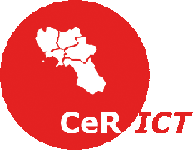The project aims to study and develop a modernization and strengthening process of regional rail networks, increasing the safety level and transport capacity, taking advantage of new tracking and telecommunications satellite technologies and their integration with terrestrial ones, both traditional and innovative. In particular, these technological innovations will encourage the development of rail systems, as part of the regional transport, reducing the cost of operation and maintenance, as well as the cost of initial investment to build new lines and / or enhance existing ones.
The above-mentioned objectives will be pursued through the minimization (as a reduction) in installations along the line, concentrating the installation of innovative technological equipment on board of railway vehicles.
The project also aims to analyze and implement a virtualization process (as a replacement of physical components with equivalent virtual components) which, ensuring functional equivalence of the traditionally used components for railway signaling, has the additional benefit of allowing a technological upgrading and a possible enhancement of apparatus performance.
The significant reduction of the "wayside" interventions and the "virtualization" approach will facilitate from the economic point of view the "migration" of existing solutions to innovative ones, ensuring coexistence and thereby allowing possible graduation of required investment for the modernization process.
Enabling and innovative technologies constituting the signaling components are based on "safe" satellite tracking systems as well as technologies of satellite communications and terrestrial mobile phone networks (2G or 3G), whose technological infrastructures are already available and do not require particular investments. In the field of satellite positioning, in particular, we will evaluate the possibility of using, in addition to the GPS system, even the EGNOS-GALILEO system on which the European Commission is planning new investments to encourage its use in the railway field. The extended use of GNSS (Global Navigation Satellite System) is born from the need to increase the robustness of the system, with benefits on the availability of the offered service.
Beyond the use of the satellite technology, in the project the development of complementary elements in support to the rail traffic management systems (signaling systems), will be considered in order to increase the overall level of availability and accuracy of the features that may be critical in the railway sector. More specifically, we will evaluate innovative solutions for communications networks to be prepared along the line and on vehicles to ensure and improve ground-air and ground-to-ground communications. The primary objective is to integrate different wireless and wired technologies to achieve the quality service levels required for the safe management of rail traffic and without necessarily establish a network dedicated TLC.
The participant to the proposal are located in a strategic position to implement new technologies and export solutions both on a national and European level. Ansaldo STS has obtained in the scope of the European rail industry (UNIFE-UNISIG) the coordination role to define the requirements of the new satellite tracking system for the development of ERTMS and, through the European Space Agency, is already building the core technologies to validate them in the railway environment, in a special Test Site to be implemented in Sardinia with the involvement of RFI. The Test Site has in particular the objective of validating the EGNOS-GALILEO system's compliance with the railway requirements. The first results of the project 3InSat ( in which Ansaldo STS participates and that will be completed in 2014) will be used in the FERSAT project to do a further technological advancement especially focused to the needs of modernization of the high capacity regional lines (metropolitan open) that require tracking systems capable to guarantee the safety performance even in partially obstructed areas (eg, tunnels and / or in presence of interference caused by radio emissions typical of urban environments). Moreover, the presence in the structure of the proponents of SME expert in rail technology, and the involvement University of Campania Region through the CeRICT, facilitate an effective integration in the design of innovative telecommunications technologies both satellite and terrestrial, regarding the problems of localization and communication.
In terms of research new themes for the railway sector will be studied, ranging from satellite tracking techniques with safety requirements imposed by the CENELEC standards, to the multi-constellation use (GPS, Galileo, GLONASS), a hybrid localization techniques based on the joint use of satellite and terrestrial technology, generally more traditional for both indoor scenarios (such as tunnels) and outdoors.





